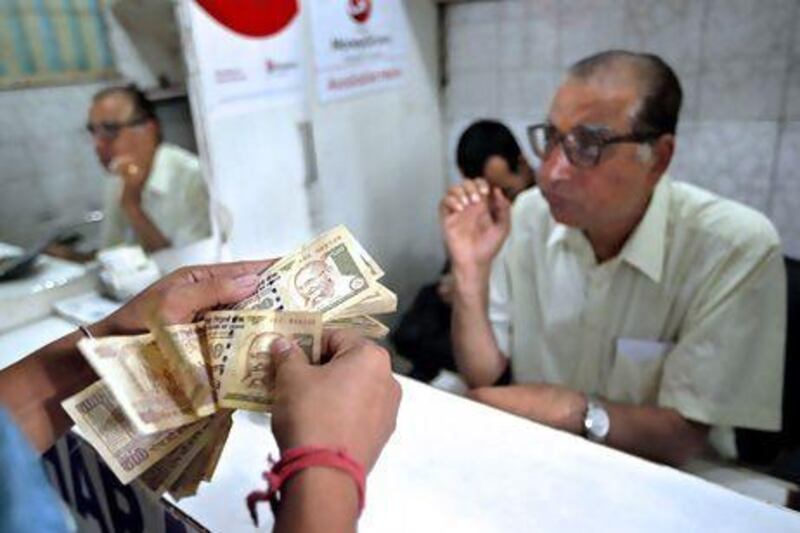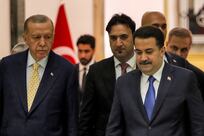But the currency's decline is making imports more costly. As India buys a great deal of oil and gold, this will compound the current-account deficit woes. But expatriates are cashing in and remittances are soaring.
The slide of the rupee has far-reaching implications for India's economy.
The currency tumbled to record declines this month, hitting an all-time low of almost 60 to the US dollar in trading on Thursday.
"It is definitely a worrying sign," says Varun Goel, the head of portfolio management at Karvy. "Rupee weakness has a big impact on the Indian economy."
The currency's woes have been compounded by the United States appearing to be set to curb its appetite for printing money as well as India's large current account deficit.
India imports far more than it exports, with imports of oil and gold being particularly high. A weaker rupee makes imports more costly, which is a concern after the country's economic growth hit a decade low in the past financial year.
"The price of imported goods like crude oil and machinery components increases, causing upward pressure on inflation," said Mr Goel. "The import bill continues to get bigger with further pressure on the current account and thus leading to further rupee weakness. So it becomes a negative loop. Several manufacturing companies which depend on imported raw materials lose competitiveness."
Some companies have far greater exposure than others.
"On the losing side would be companies which have higher exposure to foreign currency loans, for example Bharti Airtel, Reliance Communications, according to analysts at Icici Securities. "Also, companies, for example Maruti Suzuki, which use imported raw materials in the form of commodities would also be negatively impacted in the profit and loss statement," they wrote in a report.
On the flip side, firms that export goods and services stand to benefit if they have inflows of foreign currency, which can now buy more rupees.
"US dollar appreciation would be positive for sectors like IT, pharmaceuticals, which have earnings in foreign currency," Icici said. It cites the IT giant Infosys as one company that could stand to benefit from the rupee's decline.
"Though the steep Indian rupee depreciation would benefit the exporters, India being a net importer, would be at the losing end in the immediate future. In the financial year 2013 [which ends next March] our trade deficit stood at US$196.5 billion."
The electrical and electronics sector is an area that is highly dependent on buying products from abroad.
"The slide in the rupee has been swift and gradual over the past one month, which has hurt the majority of the import-dependent industries, including electrical equipment importers," said JG Kulkarni, the president of the Indian Electrical and Electronics Manufacturers' Association.
"During the last five years, India's imports of electrical equipment imports have increased at a CAGR [compound annual growth rate] of 30.30 per cent and were at $15.7bn in 2011 to 2012.
"Companies, which have taken forward bets on the rupee in anticipation of the fall, are likely to benefit compared with firms with unhedged positions on the currency."
With the prices of imports increasing because of the weak rupee, this then pushes costs up for consumers, and feeds into inflation.
Concerns about the currency's slide prevented the central bank from cutting interest rates this month, although industry leaders argue that lower rates are needed to help boost the faltering economy.
"On the global front, rising global yields, a strong dollar coupled with concerns around tapering of US stimulus spending have put pressure on emerging market currencies, particularly those running current account deficits," said Arun Khurana, the head of the global markets group at IndusInd Bank.
"If you look at South Africa, India, Turkey, Brazil and Mexico, you will realise it's a global phenomenon. On the local front, concerns around exacerbation of existing current account deficit, FII [foreign institutional investor] selling of Indian debt, increased levels of gold imports in the months of April and May have led to this sudden and unexpected weakening.
"Weak growth, lack of speedy reforms, political uncertainty do not augur well for the rupee," he added. "A 9 per cent move in the currency clearly indicates that the fault lines are too deep and wide to be corrected in the short term."
Anand Rathi, a private bank, predicts that the rupee could bounce back to 54 to 55 against the dollar by September, as government measures to curb gold imports and lower commodity prices help India to trim its current account deficit. It warns that the longer term outlook for the rupee is uncertain "due to a lack of meaningful measures to tackle the current account deficit and uncertainty over capital flows".
There are some who are hoping that the currency will remain depressed.
Sudhesh Giriyan, the vice president and business head of the remittances company Xpress Money, said this was "a very interesting time for the rupee. It's great news for non-resident Indians because they can buy more rupees with their dollars".
Mr Giriyan added there had been a surge in remittances because of the rupee's weakness, with growth from flows from the UAE to India up as much as 15 per cent.
"Whatever is happening right now suits us well because on the non-resident India side since the sentiments on positive, they are always waiting to take advantage of the depreciating value. It's good news for us as a company."
The property market in India is also likely to benefit as expatriates take advantage of the currency's decline to buy homes.
"Because of the differential rate, the value of the money in the hands of expatriate workers in Indian rupee terms is more, so they have more disposable income," said VK Sharma, the managing director and chief executive of LIC Housing Finance.





